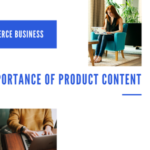When starting an online e-commerce store, it’s natural that the first thing you think about are the products. Identifying what you’ll sell, for how much, and how it will be organized are fundamental to building an e-commerce brand.
One underrated aspect that’s just as important is the e-commerce content.
With an eye on the top e-commerce trends for 2021, you can position your e-commerce storefront for big things. If content is ignored now, it tends to slow your marketing and product launches down later when you’re forced to play catch-up.
Content has been quite the buzzword in digital marketing for a while, and for good reason. Content is how users interact with any website or brand. They watch video content and read blog content; they download ebook content and give you their emails; you then send them email content and retarget them with some snazzy ad content along the way.
When you show consumers the products that really sparks their interest, they land on your product page and consume your e-commerce product content.
This whole ecosystem makes up what we call e-commerce content. Even the enriched photos and product bullet-points loaded to a marketplace fall under this umbrella. Brands have been doing some exceptionally cool stuff with their e-commerce content of late, and the brands that aren’t…simply aren’t getting noticed.
To make a splash in 2021 and use your e-commerce content to get more sales, follow along as we go through the five e-commerce content trends you’ll be happy you knew about!
1. Content marketing and the new degree of consumption
Even beginner e-commerce entrepreneurs know that content marketing is an excellent way to get consumers engaged. Of course, it’s important that content isn’t created just “for the sake of creating it.” No content is inherently good enough to get noticed.
With a more strategic approach to content marketing, the horizon starts to look far brighter. Consumers will find the answers they were looking for in your blogs, they’ll be entertained by your social videos, they’ll want to download your freebies, and they’ll even engage with your emails.
Looking to today’s trends, a lot happened in 2020, most of which brands are still trying to keep up with. One of the biggest and most measurable shifts, though, happened early on in the global pandemic. As soon as lockdowns went into wide effect, consumers started doing what they do best…consume. But now, they were consuming differently. Not only had shopping moved online for just about everything, but consumers were also spending twice as much time online consuming content as they had just a few months before.
This trend in high consumption of online content hasn’t slowed, and it won’t in 2021, either. To ride this wave, start by getting your e-commerce content strategy in place, so it can drive buyers right to your storefront. Content “for content’s sake” might be a waste, but with e-commerce content carefully crafted for every step in your funnel, you’ll see higher engagement across channels.
2. Video done right
Consumers engage visually with brands via video. Whether they’re how-to or product videos (or anything in between), video consumption keeps increasing.
In 2021, we’ll kick off with a new standard of video that consumers acquired in 2020. Video consumption has been on the rise for years, and Facebook even predicted that their platform would be video-only (i.e., with no text content) by the end of 2022.
What’s special about 2021 is this new video-centric standard set forth by marketers in 2020.
With users shopping online for absolutely everything that can get shipped or couriered, videos took center-stage in 2020 as the best way for them to visualize a product before buying it. Instead of clicking through static photos, a video could give each buyer a 360-degree look at a product in its intended environment.
A simple video taking a quick spin around a product, however, wouldn’t cut it. With so many brands trying to get their piece of the pie in e-commerce, brands stand out when they create videos that mix ad language with the lifelike product views online shoppers were hungry for.
A few of the important components of engaging videos for 2021 include:
- They tell a story: provide context by showing your product in use or showing the result of a service you provide.
- They’re short: keep your e-commerce product videos down to 30 seconds or less. This is especially important to make the video shareable on all your social profiles.
- They feel human: product showcase (aka “product explainer”) videos make products and services relatable. Consumers should feel like you understand them and what they want.
The best e-commerce video content hits these three notes to varying degrees. 2021 will shape up to be the biggest video-watching year ever—will your brand sleep through it?
3. Something to talk about…
Active use of Alexa and other voice-controlled devices has done a lot to shape the e-commerce landscape for 2021. You can tap into just about every moment of need or want in a consumer’s world now as long as they articulate it.
Voice search has to be front-and-center in e-commerce content strategy. Part of this trend results from the rising adoption of Google Home and other smart speakers plus virtual assistants like Apple’s Siri. Another part is how website accessibility has impacted SEO in recent Google updates.
- What to know about smart speakers: According to Salesforce, 4 out of 10 millennials search online through voice assistants (like Siri) before buying a product. Generation Z has just aged into the consumer-spending limelight, too, and will use voice assistants even more. So, if consumers are looking for products to buy using voice search, your product data has to be optimized to factor in the syntax of natural speech.
- What to know about accessibility: Google has continually updated their algorithm to favor voice search more and more. Part of this is because of new “accessibility” standards (meaning how easily a person who is blind or deaf can navigate your website). Voice search optimizations come hand-in-hand with voice reader optimizations, because your content—including metadata on every photo and video—has to be intuitive when read aloud.
Ensure your e-commerce content (including back-end meta and product data, too) is optimized for voice by:
- Weaving in the questions someone might ask aloud if searching for your product
- Remembering to work in local search SEO data
- Optimizing your listings by marketplace (because Alexa, for example, will send someone to an Amazon product page while Google Home might choose another platform)
When we get into the nitty-gritty of different “versions” of product data for each platform or marketplace, we start barking up the product information management tree. This is an enormous and practically impossible undertaking for e-commerce brands without the right systems in place. Product data is easily managed in product information management software (PIM), and forward-facing brands see it as a given if they want to optimize their product content across multiple channels.
4. Enhanced content is now essential
Once upon a time, product data like descriptions, titles and bullet-points were considered “essential product content,” while content like photos were considered “enhanced product content.”
Today, the standard for enhanced content has come to be much higher, and what was once for-funsies enhanced content is now fundamental content for every brand.
Two out of three shoppers report abandoning a sale because they couldn’t find the information they needed about a product. E-commerce shoppers today, as it were, also have much higher expectations of the “information they need.” They need to practically hold the product.
Consumers are definitely feeling the absence of the in-store shopping experience. They can’t feel an item or try on a garment. This is where enhanced content has become essential.
Examples of enhanced content to prioritize working into your product pages for 2021 are:
- Longer product descriptions with incorporated visuals and callouts
- 360-degree product tours
- Instruction manuals and downloadable specs
- Product comparison charts
- HD videos with products in context
- Photos of products from multiple angles
- Photos of products with overlays providing additional product information
Weaving in enhanced product content will make your brand more trustworthy and will help your e-commerce content convert faster and with fewer returns.
5. Content will shape your UX
E-commerce content has changed the online shopping user experience (UX) forever.
To create the best online shopping experience (i.e., the quickest, easiest and most informed path to purchase) requires a thoughtful UX. Think about it like you would a purchase in a physical store. Each product has to be well presented, right? You walk up to a mannequin whose classy shirt attracted your attention. You peer around the back and see how the fabric hangs across the shoulders. You decide to try it on. Then you buy it.
Use your e-commerce content to deliver the same experience online. Craft the titles that complement that first, attention-grabbing photo. Then ensure that the first photo leads right into the enriched photos or videos that give a 360-degree view of the product. Use contextual photos or augmented reality to help the buyer “try it on,” and then provide the optimized bullets and other specs to give the buyer the confidence to hit “buy.”
Ignoring the UX—and the power you have to shape it through your e-commerce content—is a trap you don’t want to fall into. The consequences of poor e-commerce UX could leave you out of the running in 2021.
By coming up to 2021 with a hard and strategic look at your e-commerce content, you can use content assets the way the new e-commerce market intended you to. Follow these trends to more consumer engagement with your products. All your content should be interconnected and should provide buyers with a delightful experience as they make their way to the check-out.
Great content will stand the test of time as your e-commerce company grows. Nothing’s stopping you from aggregating your product information and starting to polish your content now!
 Author Bio:
Author Bio:
The following blog was written by guest author Alex Borzo, a content contributor at Amber Engine, a software company passionate about eCommerce. The company’s fast and simple PIM software gets sellers, distributors and brands to Amazon and other online marketplaces in weeks instead of months.
For a successful e-commerce business, conversion is the key that enables you to survive in the fierce competition and to turn traffic into conversion, you need to maintain a constant conversation with your customers. You must get your product description effective in a way that users feel connected and engaged. If you’re thinking how’s that even possible? Meet Adzis, our AI based Product Description Generator that can generate thousands of compelling product descriptions straightaway. You can check our site for more details: https://app.adzis.com/



 Author Bio:
Author Bio:

